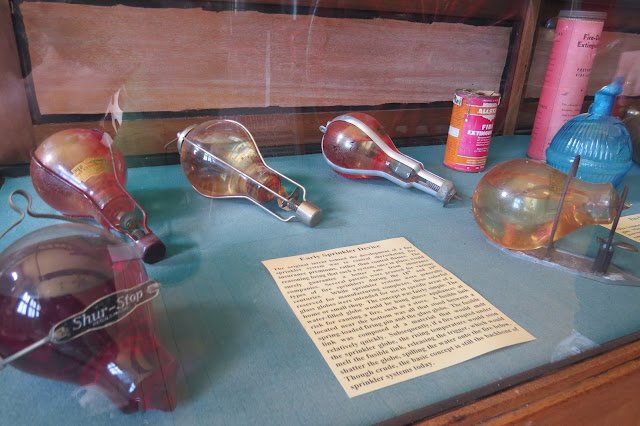When we went to downtown Racine recently I got out to take some shots of what I now know is Fire House No. 1 at 1412 Racine Street. It was built in 1882 and online research indicates that S.C. Johnson purchased the property in 2009 and plans to preserve it. That's great news for historic architecture and fire fighting history fans, and a nice gesture by S.C. Johnson. Hope they clean her bricks up soon, it would look so beautiful once it was sandblasted.
I have to add that I am
not a fan of S.C. Johnson in general as they sell
products that are tested on animals....hope they change that policy!
I have had Racine's Fire House No. 3 on my to-do list because it's been turned into a museum. The building has been preserved to reflect the early 1900's and tours are given by appointment only.
Centerpieces of the Museum include the 1882 Stephen Freemen Steamer
which is a Silsby 600 gpm steamer and a 1930 Pirsch 1000 gpm motorized
pumper. Other artifacts include a working Gamewell System, Helmets,
Hydrants, Nozzles, Hand Drawn Hose Cart, Trophies and Awards which were
won by Racine Fire Fighters in the mid to late 1800's, an extensive
collection of breathing apparatus from the 1920's to present, and many
other pieces of fire fighting history. I contacted the museum and was thrilled when they offered me a private tour. Steve was happy to answer all questions that Katrina and I threw at him. If I got any of the details wrong it's due to my memory and not the quality of Steve's information!

One of the interesting things we learned about was the early ticker tape setup. If there was a fire you pulled the alarm and each alarm box had a number that corresponded to the address where it was located. The alarm triggered the bells to ring and after Steve pulled the alarm for box #126 on the right, the overhead bells in the stations rang first once, then twice, then six times. In addition to the bells signaling "126", the ticker tape pictured below punched out one hole, then two holes, then six.
Also of interest was the history of fire extinguishers and early sprinkler systems. My favorite was the blue fire extinguishing "bomb" on the right that you threw at the base of a fire that was full of chemicals to put out the fire.
Early firefighters also used "Speaking Trumpets" similar to today's bullhorns to try to direct the action at a fire. I thought the
silver plated engraved commemorative trumpets were so beautiful.
The highlight of the tour for most visitors is the engines of course. So many details, where does a photographer even try to begin? When a call came in, the horses were let out of their rear stables by automatic doors and took their places as the harnesses were automatically lowered. A little competition arose between the stations and one station claimed they could be harnessed up and out the door in 15 seconds!
The hand tooled leather of the old fire helmets is very intricate work. If you want to know more about how they were made and why they are designed the way they are I found a good link
here.
White fire helmets were for the Chief, firefighters wore black. And apparently the Racine Firebells were distinguished by their orange helmet.
The Fire Bells run the No. 3 Museum and provide food, water, and temporary shelter from the environment for fire fighters and fire victims alike.

Racine is lucky to have so much fire fighting history still preserved. Four of the six pictured historic firehouses are still standing in Racine. I was in love with the prints at the scenes of fires like the one shown below that were on display upstairs. They were the originals: faded, curling, and with that delicate patina that can't be reproduced.
On Monday I'll delve a little bit into the history of dalmations and fire fighters because I found a great local mural to help tell that story!












































